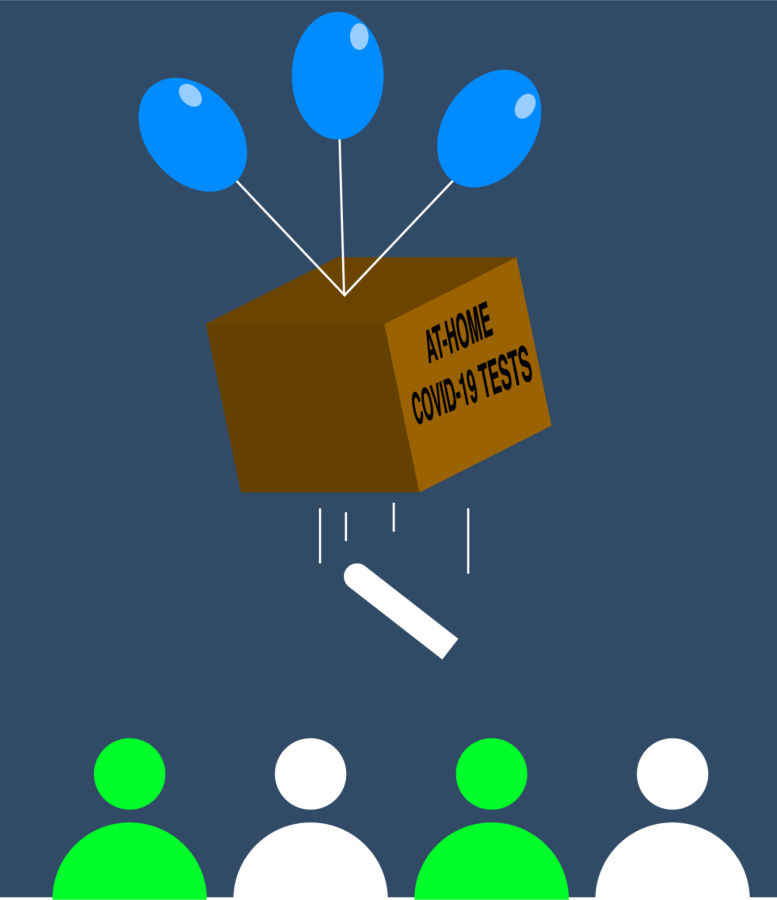Editorial | President Biden’s free at-home rapid COVID-19 tests are too little too late
January 26, 2022
COVID-19 was declared a global pandemic by the World Health Organization on March 11, 2020. Nearly 100 weeks later, President Joe Biden’s administration has begun administering free at-home rapid tests to protect the public.
Within this gap, however, about 68 million cases in the United States were reported to the Centers for Disease Control and Prevention — this statistic largely doesn’t count those who tested positive with at-home tests like those now being delivered — and the death toll has approached 900,000 Americans.
Nevertheless, President Biden recently announced every American residence with private insurance will be eligible to request eight “free” tests a week, amounting to 32 a month. Moreover, the Biden administration has purchased 500 million at-home rapid tests and soon seeks to provide Americans free “high quality” masks in preparation for their latest pandemic push.
Although President Biden’s policy finally provides free testing to most Americans, this announcement arrives three years too late: Successful testing, quarantining and contact tracing may have warded off COVID-19 in early 2020, but in 2022, the virus can’t be controlled with testing. Vaccines and masks have triumphed over testing as the best options to solve COVID-19; testing is no longer the COVID-19 answer it once was — especially as Omicron rages on and becomes the dominant variant.
In addition to being too little too late, there is a genuine concern these tests are not evenly distributed. Despite each eligible American being given an equal number of tests, the proportion is not enough for households larger than four individuals. With low-income households typically larger than others, the policy isn’t too beneficial for these frontline families.
Get The Daily Illini in your inbox!
Generally working in “essential” jobs with profound exposure risks, low-income households deserve a more equitable policy that delivers more tests to them. Accordingly, an awkward “insurance will pay for it” policy is a bureaucratic solution that, instead, should be straightforward and free (insurance or not) so all Americans can easily test.
Similarly, when the website first launched, complications occurred for those in multifamily housing — common to low-income families — as the site wouldn’t allow those in apartments, for example, to order the tests. Claiming they had already ordered, the website couldn’t recognize more than one household in one residence/building.
There is also a concern as to how insurance will cover these looming costs. For now, little is revealed as to how/why insurance will cover the costs (other than pressure from President Biden). Consequently, some are anxious whether or not insurance rates will rise in response to allowing “free” tests.
Fortunately for Illini, testing was/is almost always easy. Utilizing the University’s SHIELD system, testing for students, faculty and staff has been free and relatively accessible. Likewise, compared to the national testing environment, Champaign-Urbana has been a safe, vigilant bubble. Where other communities struggled to receive convenient testing, since mid-2020 the University community has been able to successfully test itself.
If the U.S. still sought a better testing policy, SHIELD would serve as a better model rather than the at-home rapid tests. Besides numerous complications – such as the possibility that SHIELD prospered because of its university backing — SHIELD supersedes the at-home tests with its polymerase chain reaction test accuracy and accessibility (free on-campus walk-ins compared to registering on a government website).
Thus, the University followed common sense by providing a better “free” approach to testing. While the rapid, at-home tests utilize nasal swabs and, for now, results aren’t immediately reported to health authorities, the SHIELD system’s saliva testing is non-invasive and results are shared with relevant health departments.
The Biden administration’s new policy to stop COVID-19 is better than no policy, yet its inequitable and delayed aspects may not be a game-changer. An improved system, nonetheless, would model itself from SHIELD and allocate more tests based on economic levels.
It’s also helpful to continually promote vaccines as the best option to repel COVID-19. Testing is necessary and crucial, but vaccines should be marketed as the better alternative — particularly as the U.S.’s vaccination rate appears to stall around 63% fully vaccinated.
Furthermore, any future policies delivering a common COVID-19 solution must consider equity over equality. Eight tests a week for a household may be a surplus for some while scarce for others. Therefore, President Biden and other political leaders must think in terms of addressing COVID-19 today, not catching up to last year’s promises.







